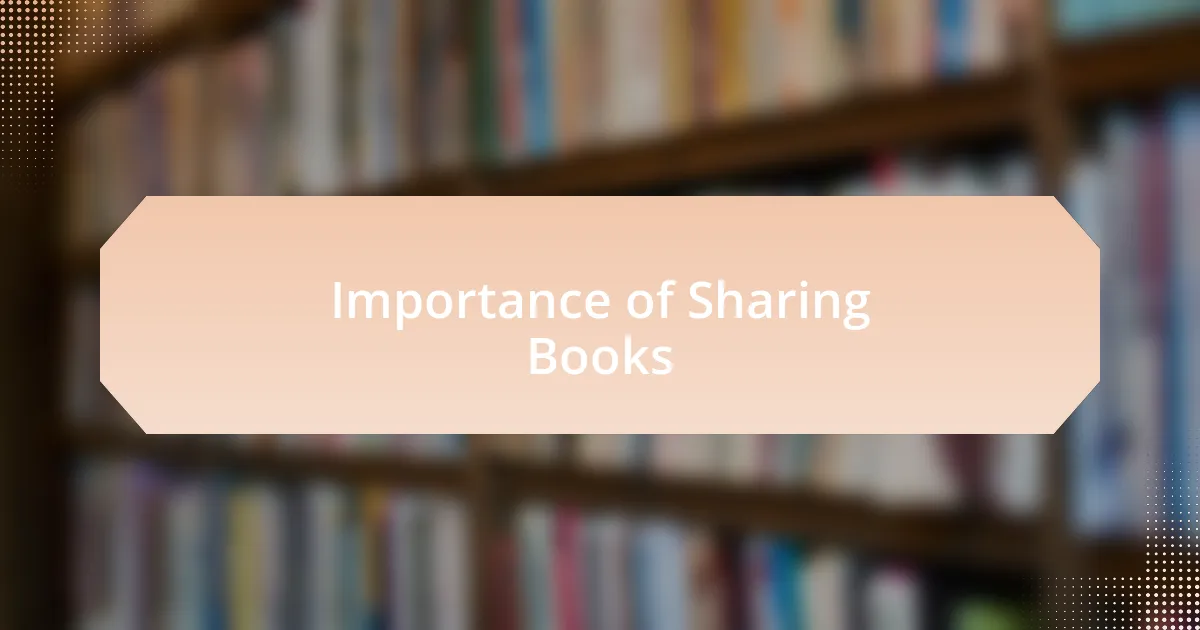Key takeaways:
- Prayer books serve as vital tools for spiritual reflection, enhancing personal faith and community worship.
- Sharing prayer books fosters deeper connections and meaningful conversations about faith, acting as a bridge between individuals.
- Personalizing the sharing experience, such as writing notes or organizing gatherings, can enrich the connection and understanding of spiritual insights.
- Creating a structured sharing schedule and an open discussion environment encourages engagement and fosters a sense of community among friends.

Understanding Prayer Books
Prayer books play a crucial role in many religious traditions, serving as a guide for spiritual reflection and community worship. I remember the first time I used a prayer book; it felt like a doorway to a deeper connection with my faith. Have you ever felt that surge of warmth during prayer, as if the words were wrapping around you like a comforting blanket?
These books often contain a collection of prayers, hymns, and meditations, tailored to specific occasions or moods. I once found myself turning to a prayer book during a particularly challenging time, and it was fascinating how a simple prayer could shift my perspective and bring me peace. Isn’t it remarkable how the right words at the right moment can resonate deeply?
Moreover, sharing a prayer book with a friend can enhance your connection, fostering intimate discussions about faith and spirituality. I often find that these books spark meaningful conversations, allowing both of us to explore our beliefs and feelings. Don’t you think there’s something powerful about praying together, even if it’s through the words written on a page?

Importance of Sharing Books
When I think about the importance of sharing books, I recall a time when I gifted a beloved prayer book to a close friend who was seeking comfort. Watching her connect with the pages was a reminder of how sharing these texts can create deeper bonds. Isn’t it fascinating how a book can suddenly become a bridge connecting two hearts?
Sharing books, especially prayer books, not only spreads knowledge but also fosters a sense of community. I’ve often noticed that discussions sparked by shared readings bring us closer, encouraging us to express our thoughts and feelings openly. Have you ever experienced that moment when a shared story ignites a rich dialogue you never expected?
Moreover, sharing books can be a powerful act of love and support. A friend once shared a prayer book with me during a difficult season of my life, and it became a lifeline. It made me realize how books can offer solace and understanding, particularly when they carry the weight of someone else’s experience alongside your own. Don’t you think that the act of sharing becomes a gesture of compassion that transcends the written word?

Ways to Share Prayer Books
When I want to share a prayer book with a friend, I often personalize the experience. For instance, I might write a heartfelt note on the inside cover that reflects my thoughts about the book and why I believe it will resonate with them. Isn’t it amazing how a simple message can add layers of meaning to a gift?
I’ve also found that discussing the prayer book over coffee can enhance the sharing experience. I once invited a friend over to explore my favorite passages together, and we ended up embarking on a journey of faith and reflection. Have you ever noticed how sharing a moment of connection like that can deepen your relationship and inspire new insights?
Another wonderful way to share prayer books is by organizing a small gathering, where friends can bring their own favorites and discuss them. I remember hosting a cozy evening where everyone brought their treasured texts, leading to a vibrant exchange of ideas and experiences. It reminded me that sharing prayer books can create a collective atmosphere of growth and understanding. Doesn’t it feel uplifting to belong to a community that nurtures spiritual growth?

Choosing the Right Prayer Book
When choosing the right prayer book, I often consider the specific needs and backgrounds of my friends. I remember selecting a book for a close friend who had just started their spiritual journey. I wanted to make sure the language and themes were accessible, so I went for something that was both inviting and profound. Have you thought about how important it is to match a book’s tone with the reader’s level of experience?
Another factor I find crucial is the relevance of the prayer book’s content to the recipient’s life circumstances. For example, I once chose a book focused on gratitude for a friend who was going through a tough time. It allowed her to reflect on the good amidst her struggles, creating a space for healing. How often do we underestimate the power of words tailored to someone’s season of life?
Additionally, I believe the physical design of the book can enhance its appeal. When I gifted a beautifully illustrated prayer book to my sister, I noticed how its aesthetics sparked her interest and made her more eager to explore its pages. Don’t you think that a well-crafted prayer book adds a layer of beauty to the spiritual experience, making it feel more special?

Creating a Sharing Schedule
Creating a sharing schedule can streamline the process of passing prayer books among friends. I remember one time when my circle of friends and I decided to establish a rotating schedule; it kept things organized and ensured everyone had a chance to dive into different spiritual insights. Have you ever thought about how a simple timeline can deepen the experience of reading together?
One helpful method I’ve found is to set specific time frames for each book—perhaps one week for shorter books and two for more in-depth ones. This way, we can all stay engaged without feeling rushed. I still chuckle when I think about the first book we shared; we underestimated its impact, and it took us all by surprise how much we wanted to discuss each section as we moved through it. Isn’t it interesting how a little structure can spark heartfelt conversations?
Lastly, I suggest keeping a group chat or shared document where everyone can jot down thoughts and reflections during their reading periods. This addition not only keeps spirits high but also fosters a sense of community as we share insights. I recall the joy I felt when my friend left an emotionally charged note after reading a particular chapter; it opened up new avenues of understanding for us all. How can such shared moments not enrich our spiritual journeys together?

Tips for Discussion After Sharing
When discussing the insights gained from a prayer book, it’s essential to create an open and supportive environment. I remember a time when a friend hesitated to share her thoughts because she feared they might not align with the group’s beliefs. I encouraged her, reminding her that diverse perspectives can lead to richer conversations and deeper understanding. Isn’t it fascinating how vulnerability can foster connections?
As we dive into discussions, I find it useful to ask open-ended questions that prompt reflection. For example, I might ask, “How did this chapter resonate with your personal experiences?” Not only does this invite everyone to share, but it also shifts the focus from a single narrative to a collective journey. I can still hear the animated chatter from our last discussion—each story interweaving with others, creating a beautiful tapestry of faith and experience.
Lastly, summarizing key points at the end of our discussions can be incredibly beneficial. I usually share a brief recap of what we’ve talked about and ask for any final thoughts. This method not only reinforces our learning but also ensures that no one leaves with lingering questions. Have you noticed how summarizing can often clarify complex ideas, making them easier to digest later?